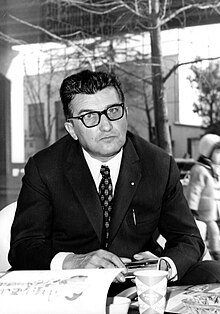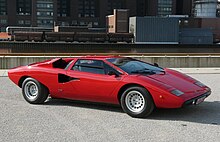Ferruccio Lamborghini
Ferruccio Lamborghini (born April 28, 1916 in Renazzo , † February 20, 1993 in Perugia ) was an Italian engineer , entrepreneur , automobile and helicopter designer, father of the Lamborghini car brand and well-known winemaker .
Youth, military
Ferruccio Lamborghini was born in a small village near Bologna . His parents were farmers. As a child he showed an interest in technology and mechanics. He finished his technical studies in Bologna and shortly afterwards he was able to test his knowledge when he was entrusted with the repair of military vehicles on Rhodes in Greece during World War II .
Tractors
After the war, Lamborghini bought old military vehicles and converted them into tractor-like vehicles (Italian: carioche), which were urgently needed in post-war Italy. According to legend, he had the idea for this on his honeymoon, which he broke off prematurely. He started a company called Lamborghini Trattori in Cento in 1949 , which made tractors. As a result, his tractors could be delivered a little later (1952) with two-, three- and four-cylinder diesel engines that came from Lamborghini's design and production.
As early as 1954, he was the first tractor manufacturer to offer direct injection and air cooling. Among other things, this made Lamborghini one of the largest tractor manufacturers in Italy.
Burners and air conditioners
Looking for new challenges, Ferruccio Lamborghini began manufacturing heating and air conditioning units after a visit to the USA. For this he founded the company "Lamborghini Bruciatori".
helicopter
With the money he earned, Ferruccio Lamborghini plunged into a company he had long dreamed of: the manufacture of helicopters , emulating famous manufacturers such as Conte Corrado Agusta ( MV Agusta , motorcycles and helicopters). However, since he did not receive any licenses for this from the Italian government, he decided to continue to devote his attention to tractor construction.
Sports car
Since the early 1960s, Ferruccio Lamborghini thought about expanding his business to include automobile production. In the literature, these considerations are often attributed to an alleged rift between Ferruccio Lamborghini and Enzo Ferrari , who - depending on the source - is said to have refused to modify his clutches or the cylinder heads of his sports cars according to Lamborghini's ideas or to give Ferruccio Lamborghini a conversation receive. Ferruccio Lamborghini has participated repeatedly in spreading these stories over the decades. Their veracity, however, is doubted. Other representations assume that Ferruccio Lamborghini and Enzo Ferrari never met in person. Rather, Lamborghini started sports car production primarily with the aim of advertising its tractor business; the alleged animosity towards Ferrari was merely a PR tool. Finally, an Italian source sees Ferruccio Lamborghini's “love of everything mechanical” as the decisive reason.
Lamborghini opened a car factory in Sant 'Agata in 1963, called Automobili Ferruccio Lamborghini SpA, which presented its first prototype in 1963 with the 350 GTV and began delivering vehicles in 1964. The first car produced by Lamborghini was the 350 GT . The later Lamborghini Miura , named after the name of a Spanish fighting bull breeder , achieved great fame. The Lamborghini Miura, equipped with a twelve-cylinder mid-engine , was immediately successful in competitions against Ferrari racing cars. Lamborghini's most famous model is the Countach , which was produced from 1971 to 1989.
In 1972 Ferruccio Lamborghini had to sell his company because of economic problems. From then on, he operated in Borgo Panicale, Umbria , viticulture on an estate that he had acquired for hobby purposes.
His factory produced cars that for many represent the ideal of beauty and perfection in automotive engineering. They met Ferruccio Lamborghini's wish for the best. Even today, Lamborghini's sports cars are the epitome of luxury and sportiness.
Once, in 1948 , he was also active as a racing driver. At the Mille Miglia he drove a Fiat 500 Topolino , but retired prematurely due to a technical defect.
Wine
He also went his own way with the winery: the Lamborghini wines are not "typical of the region". The typical Italian grape varieties officially recognized for this region are blended with the Cabernet Sauvignon grape variety imported from France in order to give them the power and finesse of Bordeaux wines combined with typical Italian wine qualities. As "atypically produced wines" they have no official recognition as DOC wines; they must be labeled and sold as "simple country wine" at the lowest level permitted for wine sales.
However, word got around early on about the exceptional quality of his wines, and since the early 1990s the Lamborghini "country wines" have reached the international high-price segment: for example, the 2001 Lamborghini wine is sold by the German importer for around 40 euros per bottle. Ferruccio Lamborghini was able to experience this success initially.
Lamborghini received the Order of Commendatore for his services to the workforce , and he was also named Cavaliere del Lavoro (Knight of Labor).
Ferruccio Lamborghini died on February 20, 1993 at the age of 76.
Web links
- Lamborghini sports car website
- Lamborghini air conditioning website
- Lamborghini tractor website
- Website of the Lamborghini winery
- Ferruccio Lamborghini at motorsportmemorial.org (English)
Individual evidence
- ^ David Lillywhite, Halwart Schrader: Classic automobiles. Motorbuch-Verlag, Stuttgart 2005, ISBN 3-613-02552-3 , p. 260.
- ↑ Reinhard Lintelmann: 1000 automobiles. History. Classic. Technology. NGV, Cologne (no year), ISBN 3-625-10543-8 , p. 335.
- ↑ Production sports car. Könemann, Cologne 1993, ISBN 3-89508-000-4 , p. 278.
- ↑ Hans-Karl Lange: Lamborghini. All sports cars since 1963. Verlagsunion Pabel - Moewig, Rastatt 1991, ISBN 3-8118-3063-5 , p. 5.
- ↑ Distancing yourself from the legends about the company founding, for example Anthony Pritchard: Lamborghini. The history of the supercars from Sant'Agata. Heel, Königswinter 2006, ISBN 3-89880-574-3 , p. 10.
- ↑ Wolfgang Blaube: Green Star. 50 years of Lamborghini . Oldtimer Markt, issue 7/2013, p. 246.
- ^ Georg Amtmann, Halwart Schrader: Italian sports cars. Motorbuch-Verlag, Stuttgart 1999, ISBN 3-613-01988-4 , p. 228.
- ^ Matthias Braun, Alexander Franc Storz: Typenkompass Lamborghini: Sports car after 1964. Motorbuch-Verlag, Stuttgart 2006, ISBN 978-3613026452 , p. 9.
- ^ Stefano Pasini: Numero Uno . Motor Klassik, issue 10/1991, p. 36.
- ↑ Lamborghini at the Mille Miglia 1948
| personal data | |
|---|---|
| SURNAME | Lamborghini, Ferruccio |
| BRIEF DESCRIPTION | Italian car maker and father of the Lamborghini car brand |
| DATE OF BIRTH | April 28, 1916 |
| PLACE OF BIRTH | Renazzo |
| DATE OF DEATH | February 20, 1993 |
| Place of death | Perugia |


